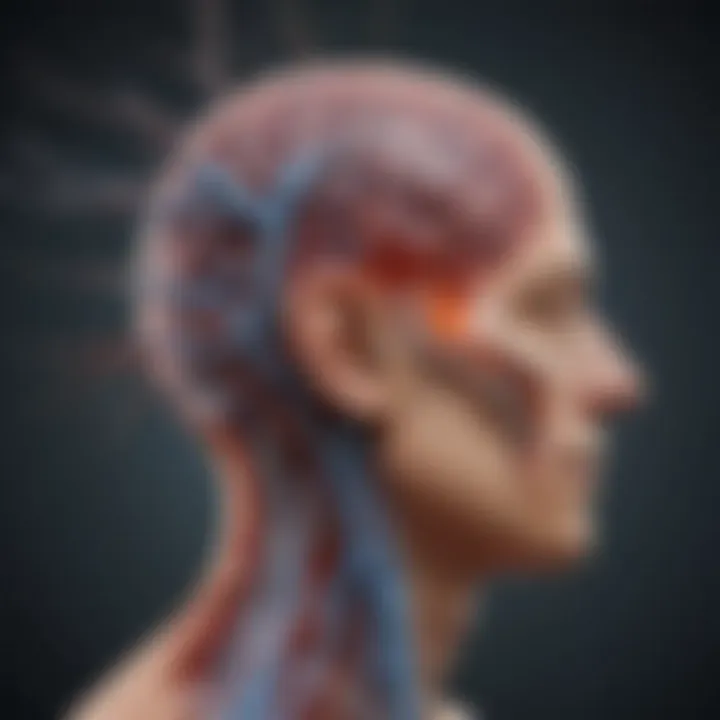Diabetes and Migraine: Understanding Their Connection


Intro
Diabetes and migraine headaches are two significant health conditions that affect millions of people worldwide. The relationship between these two issues is complex and multifaceted. Understanding this connection involves exploring how diabetes impacts the frequency and severity of migraine headaches and how migraines can complicate diabetes management. Both conditions can co-exist, leading to unique challenges for patients and healthcare providers.
This article aims to shed light on the intricate ties between diabetes and migraines, emphasizing the physiological mechanisms involved. By synthesizing current research and clinical findings, we hope to offer insights into effective management strategies for individuals facing both conditions.
Prologue to Diabetes and Migraine Headaches
The connection between diabetes and migraine headaches is an area of increasing interest in the medical community. Understanding this relationship is crucial for both patients and healthcare providers. Diabetes, a condition characterized by high blood sugar levels, can affect various body systems. Migraines, on the other hand, are severe headaches often accompanied by other symptoms such as nausea and sensitivity to light.
Both conditions impact a significant portion of the population, and their co-occurrence raises important questions about management and treatment. Studies indicate that individuals with diabetes experience migraines more frequently than the general population. This prevalence is compounded by the physiological challenges posed by diabetes, such as fluctuations in blood sugar levels, which can trigger migraine attacks.
Recognizing the intersection between these two health issues involves examining how diabetes can influence migraine severity and frequency, as well as how migraines might affect diabetes management. The relationship between diabetes and migraine is complex, involving mechanisms that require further exploration.
There are essential elements to consider in this discussion:
- Prevalence: Understanding how common migraines are among diabetic patients helps raise awareness.
- Physiological Links: Identifying the biological mechanisms that connect the two conditions can lead to better treatment strategies.
- Management Challenges: A comprehensive approach to managing both conditions is required for improving patient quality of life.
The exploration of this topic not only addresses a significant health concern but also promotes dialogue about interdisciplinary approaches. A deeper understanding can pave the way for innovative treatments and strategies that enhance the lives of those affected. As research in this field continues to evolve, staying informed about these connections becomes increasingly important for patients and healthcare professionals alike.
Understanding the relationship between diabetes and migraine headaches is pivotal to enhancing patient care and treatment outcomes.
In the following sections, each aspect of this connection will be delved into in detail, offering insights that are both informative and relevant for any interested reader.
Types of Diabetes
Understanding the different types of diabetes is crucial for exploring their connection with migraine headaches. Each type presents distinct characteristics, management needs, and potential complications. Individuals dealing with diabetes may experience various health challenges, and recognizing the differences informs how these conditions might affect migraine frequency and severity. The interplay between diabetes and migraines can vary based on the type of diabetes, influencing treatment options and lifestyle considerations for patients.
Type One Diabetes
Type One Diabetes, often diagnosed in childhood or young adulthood, is an autoimmune condition. The immune system mistakenly attacks insulin-producing beta cells in the pancreas, leading to little or no insulin production. Patients depend on external insulin delivery through injections or pumps. For individuals with Type One Diabetes, blood sugar levels can fluctuate significantly, which might induce or exacerbate migraine headaches. Research highlights the vulnerability of these patients to stress-induced migraines, particularly when managing insulin levels amidst lifestyle changes.
Type Two Diabetes
Type Two Diabetes is more prevalent and typically develops in adults. It is characterized by insulin resistance, where the body does not use insulin efficiently. Factors such as obesity, sedentary lifestyle, and genetic predispositions play significant roles in its onset. Migraines might be more common in individuals with Type Two Diabetes, correlating with obesity and other metabolic syndromes. These patients face chronic blood sugar fluctuations, potentially leading to migraines triggered by both hyperglycemia and hypoglycemia. Understanding these triggers can enhance management strategies for both diabetes and migraines.
Gestational Diabetes
Gestational Diabetes arises during pregnancy and affects how the body processes glucose. Hormonal changes during pregnancy can lead to insulin resistance, causing elevated blood sugar levels. While it typically resolves after childbirth, women with gestational diabetes are at risk for developing Type Two Diabetes later in life. The emotional and physiological stress of dealing with gestational diabetes may also contribute to migraine development. Proactive management during and after pregnancy is vital for both maternal health and migraine prevention.
Each type of diabetes presents unique challenges and may influence migraine occurrences differently. Recognizing these differences supports a more tailored approach to treatment and lifestyle adjustments, ultimately enhancing the quality of life for those facing both conditions.
Understanding Migraine Headaches
Understanding migraine headaches is essential within the context of diabetes due to the complex interplay between these conditions. Migraines are not just ordinary headaches; they carry significant ramifications for those who experience them. For individuals with diabetes, migraines might exacerbate existing health issues and complicate management.
By examining the nature of migraines, we can ascertain how they differ from other types of headaches. Recognizing the underlying mechanisms and classification systems surrounding migraines can provide care providers and patients alike with valuable insights into symptoms and potential treatments.
Definitions and Classification
Migraines are a subtype of headache disorder characterized by recurrent episodes of moderate to severe headache, often unilateral and pulsating in quality. According to the International Classification of Headache Disorders (ICHD), they can be classified into various types, including:
- Migraine without aura: This is the most common type. Symptoms include headache, nausea, and sensitivity to light and sound.
- Migraine with aura: In this type, individuals experience warning signs such as visual disturbances or tingling in their extremities before the headache onset.
- Chronic migraine: This involves experiencing migraines on 15 or more days per month for three months or longer.
This classification helps in determining appropriate treatment paths and understanding the frequency and triggers involved in migraine occurrences.
Symptoms and Phases of Migraines
Migraines typically progress through several phases, with each phase presenting distinct symptoms. These phases include:
- Prodrome: This phase may occur hours or even days before the migraine. Individuals might experience subtle changes in mood, energy levels, or food cravings.
- Aura: Although not everyone experiences aura, it can include visual disturbances and sensory changes.
- Headache: The main phase of the migraine, which can last from a few hours to several days.
- Postdrome: Following the headache, individuals often feel drained or fatigued.
Understanding these symptoms is crucial for effective diagnosis and treatment. Recognizing the prodromal phase, for instance, allows patients to take preventative measures before the full-blown migraine strikes.
"Awareness of migraine phases can increase patient resilience and empower better self-management strategies."
Furthermore, the relationship between migraine symptoms and diabetes needs further exploration. Fluctuations in blood sugar levels can intensify migraine symptoms, creating a cycle that requires careful management. As such, individuals with diabetes must remain informed about how their condition can influence or be influenced by migraine patterns.


The Intersection of Diabetes and Migraine
The relationship between diabetes and migraine is complex and multifaceted. Understanding this intersection is crucial for managing the health of individuals who experience both conditions. Studies suggest that people with diabetes might experience migraines more frequently than those without diabetes. This increased prevalence necessitates a closer examination of the specific factors that contribute to the emergence and persistence of migraine headaches in these patients.
Several specific elements warrant attention in this practical discourse. Firstly, the shared physiopathological pathways suggest that dysregulation in glucose metabolism may play a significant role in triggering migraine episodes. Secondly, understanding how diabetes management strategies can either alleviate or exacerbate migraine frequency is critical for effective treatment plans. Patients with diabetes must navigate both their blood sugar levels and their migraine management, influencing their overall quality of life.
For healthcare professionals, recognizing the symptoms of migraine in diabetic patients is essential. Not only can the migraines affect adherence to diabetes treatment regimens, but they can also complicate the management of blood sugar levels. Addressing these concerns requires an interdisciplinary approach that integrates insights from neurology and endocrinology.
Furthermore, knowledge of how lifestyle modifications can target both migraine and diabetes can significantly empower patients and healthcare providers alike. Recommendations for holistic management encompass dietary adjustments, exercise programs, and stress reduction techniques. These can mitigate the risks associated with both conditions and improve overall well-being.
"Understanding the links between diabetes and migraines can lead to more tailored and effective management strategies for patients facing both challenges."
By exploring the intersections of diabetes and migraine, this article seeks to provide a thorough overview, equipping readers with the insights required to support informed health decisions.
Prevalence of Migraines in Diabetic Patients
Migraine headaches are reported to be more common among patients with diabetes when compared to those without the condition. Research indicates that up to 30% of individuals diagnosed with diabetes experience migraines. This prevalence raises important questions about the nature of the relationship between these two disorders. Conditions such as Type 1 and Type 2 diabetes show varied impacts on migraine instances, yet the overall trend indicates a higher likelihood for migraine headaches in these populations.
Several factors contribute to the increased prevalence:
- Blood Sugar Fluctuations: Rapid changes in blood glucose levels, whether high or low, can trigger migraines.
- Obesity: Many individuals with Type 2 diabetes are also obese, which is another risk factor for migraine attacks.
- Medications: Some diabetes medications might influence migraine frequency or severity.
Recognizing these patterns is crucial in forming effective care strategies that can address both diabetes management and migraine treatment.
Pathophysiological Links
The pathophysiological links between diabetes and migraines are driven by several interconnected mechanisms. The commonalities can be attributed to alterations in neurovascular function and inflammation. Elevated levels of glucose have been associated with changes in the brain's blood vessels, potentially making individuals more susceptible to migraine episodes.
Moreover, systemic inflammation is noted in both conditions. Studies have found that chronic inflammation related to diabetes can trigger neural pathways leading to migraines. Understanding these links raises intriguing questions about potential treatment pathways that could mitigate the severity of migraines while improving diabetes outcomes.
Some important pathophysical connections include:
- CGRP (Calcitonin Gene-Related Peptide): Increased levels of CGRP have been linked to migraines and can be amplified in diabetes patients.
- Insulin Resistance: This condition is prevalent in Type 2 diabetes and may affect neurovascular regulation, influencing migraine patterns.
- Autonomic Dysfunction: Diabetes can lead to changes in autonomic control, potentially triggering migraine activity.
In summary, understanding these pathophysiological connections illuminates the necessity for comprehensive care strategies in patients experiencing both diabetes and migraines.
Influence of Blood Sugar Levels on Migraines
The relationship between blood sugar levels and migraines is an essential aspect to understand for both diabetes and migraine sufferers. The body requires stable blood glucose for optimal brain function. Fluctuations in blood sugar can worsen or trigger migraine episodes.
Maintaining balanced blood sugar levels not only supports overall health but also plays a significant role in managing migraines. This connection is particularly relevant for individuals with diabetes, as they are at a higher risk of experiencing these fluctuations. Recognizing how these levels impact migraine occurrences can lead to better management strategies, ultimately improving the quality of life for those affected.
Hyperglycemia and Migraines
Hyperglycemia refers to elevated levels of glucose in the blood, often a result of insufficient insulin production in the body. Individuals with diabetes may experience hyperglycemic episodes that leads to various symptoms, including headaches.
Specific studies suggest that high blood sugar levels can trigger the release of certain hormones and inflammatory markers, which may contribute to the onset of migraines. This pain response can be compounded by dehydration. High glucose levels often lead to excessive urination, which may result in loss of fluids that the brain requires to function properly.
"Understanding individual triggers in migraines can lead to effective interventions."
To mitigate hyperglycemia, individuals can consider the following approaches:
- Monitoring blood sugar levels regularly.
- Adjusting carbohydrate intake as needed.
- Staying hydrated to prevent dehydration.
- Following prescribed medication regimens diligently.
When blood sugar is managed effectively, migraines may occur less frequently and with reduced severity.
Hypoglycemia and Migraines
Hypoglycemia, the condition of low blood glucose levels, can also be a significant trigger for migraines. This condition can happen when individuals skip meals, exercise intensely without proper nutrition, or over-medicate with insulin.
The brain relies on glucose as its primary energy source. A sudden drop in blood sugar can activate stress responses in the body, leading to headaches or migraines. Symptoms of hypoglycemia may include dizziness, confusion, and fatigue, which can overlap with migraine symptoms, making diagnosis difficult.
"Timely management of blood sugar levels is key to avoiding complications."
To manage hypoglycemia effectively, patients should:
- Consume small, frequent meals to maintain stable glucose levels.
- Keep quick sources of glucose available, such as glucose tablets or sugary drinks.
- Stay alert to the symptoms of low blood sugar and respond promptly.


Awareness of these blood sugar issues can greatly enhance the overall management of both diabetes and migraine conditions.
Shared Risk Factors
The connection between diabetes and migraine headaches becomes more apparent when examining the shared risk factors. Identifying these factors is crucial for understanding the dual impact on individuals suffering from both conditions. Shared risk factors help to highlight not only the complexity of diabetes and migraine interactions but also the potential for integrated management strategies.
Obesity and Inflammation
Obesity stands as one of the most significant risk factors for both diabetes and migraines. It contributes to a state of chronic inflammation in the body. This inflammation can influence the nervous system, potentially triggering migraine episodes. Adipose tissue produces pro-inflammatory cytokines, which then disrupt normal metabolic processes and brain functions.
Recent studies indicate that individuals with obesity have a higher prevalence of migraines compared to those with a healthy weight.
Several factors enhance this connection:
- Increased Fat Tissue: This leads to greater production of inflammatory mediators.
- Insulin Resistance: Often occurs with obesity, worsening metabolic control, which can precipitate migraines.
- Lifestyle Factors: Poor diet and inactivity common in obesity contribute to both diabetes and migraines.
A comprehensive approach to weight management can reduce inflammation and potentially lessen the frequency of migraines in diabetic patients.
Genetic Predispositions
Genetic predispositions play an equally important role in the relationship between diabetes and migraines. Studies suggest that a familial history of migraines or diabetes contributes significantly to an individual's risk.
To better understand this aspect, consider the following points:
- Familial Patterns: Research shows that migraines often run in families, indicating a genetic component.
- Genetic Markers: Certain genetic variations may increase susceptibility to both migraine and type 2 diabetes.
- Impact on Neurotransmitters: Genetics can affect how neurotransmitters function in the brain, which is crucial in migraine pathology.
Understanding the role of genetics enables researchers and clinicians to identify at-risk populations, fostering early intervention and tailored treatment options that address both diabetes and migraine management.
By appreciating the shared risk factors between diabetes and migraines, healthcare providers can develop more effective interdisciplinary approaches, ensuring better patient outcomes.
Impact of Migraines on Diabetes Management
Understanding how migraines affect diabetes management is crucial for patients navigating both conditions. Migraines can not only disrupt daily activities but also complicate the management of diabetes. Medical professionals and patients alike need to focus on this intersection to improve health outcomes.
Adherence to Treatment Regimens
Patients with diabetes often follow strict treatment regimens, including insulin management and dietary control. However, when migraines occur, adherence to these regimens may waver. The pain and discomfort from a migraine can make it challenging to monitor blood sugar levels effectively or to make sound decisions regarding diet and medication.
Several factors contribute to this issue:
- Disrupted Routine: Migraines can interrupt scheduled medication times. Missing doses may lead to fluctuations in blood sugar levels, complicating overall management.
- Nausea and Vomiting: Migraines often come with nausea, making it difficult for patients to consume the necessary foods for proper diabetes management.
- Psychological Stress: The stress of experiencing frequent migraines can lead to emotional eating or poor self-management of diabetes.
These interruptions necessitate understanding how to create a robust management plan that accommodates both conditions.
Psychosocial Impacts
The psychosocial aspects of living with both migraines and diabetes cannot be overlooked. Having to cope with two chronic conditions can lead to increased stress, anxiety, and even depression. This situation can negatively influence health behaviors and the ability to manage diabetes.
Consider the following impacts:
- Increased Anxiety: Fear of migraines can lead to heightened stress levels, which in turn can affect blood glucose levels.
- Social Isolation: Frequent migraines may lead individuals to withdraw from social events, further impacting mental health and support systems.
- Burnout: Managing two chronic illnesses can lead to burnout, which may cause health routines to collapse.
These factors underscore the importance of integrated care approaches. Health care providers should address mental health alongside physical health, creating a comprehensive care plan. This can include counseling, stress management techniques, and medication adjustments as needed.
Key Takeaway: Understanding the impact of migraines on diabetes management is essential for developing effective treatment plans that consider both conditions.
By focusing on adherence challenges and psychosocial impacts, healthcare providers can offer tailored strategies. This proactive approach can lead to improved patient outcomes and better quality of life.
Management Strategies for Patients with Both Conditions
The connection between diabetes and migraine headaches presents unique challenges for patients managing both conditions. Understanding the management strategies is crucial for improving patients’ quality of life. It is vital that the approaches be tailored around their specific needs and symptoms. By integrating both pharmacological and lifestyle modifications, patients can potentially reduce the frequency and severity of migraines while ensuring optimal control of their blood sugar levels.
Pharmacological Approaches
When addressing diabetes and migraines concurrently, pharmacological interventions emerge as a significant strategy. Medications are often prescribed to manage blood glucose levels effectively while also targeting migraine symptoms. For those with diabetes, medications such as metformin can help maintain glucose equilibrium, thereby influencing migraine frequency.
For migraine management, doctors may consider triptans or NSAIDs, which can provide relief during an attack. However, it is crucial to avoid overuse of these medications to prevent rebound headaches. An important consideration is that certain migraine medications may also impact blood sugar control. Therefore, healthcare professionals must ensure a comprehensive review of the patient’s medication list to prevent adverse interactions.


Additionally, new developments in treatment, like CGRP inhibitors, show promise for patients experiencing both conditions. Monitoring and adjusting treatments based on individual responses will optimize outcomes for patients, reducing the likelihood of complications associated with either condition.
Lifestyle Modifications
Complementing pharmacological treatments, lifestyle modifications play a vital role in managing both diabetes and migraines. These changes can contribute to more stable blood sugar levels and potentially decrease migraine occurrences.
Some effective lifestyle modifications include:
- Dietary Adjustments: A balanced diet low in refined sugars and high in complex carbohydrates can stabilize blood sugar levels. Including magnesium-rich foods might also benefit migraine sufferers, as magnesium deficiency is linked to increased migraine frequency.
- Regular Exercise: Engaging in consistent physical activity can enhance insulin sensitivity and boost overall health. Exercise should be adapted to individual capabilities, considering any limitations imposed by migraines.
- Stress Management: Stress is a known trigger for migraines. Techniques such as mindfulness, yoga, and other relaxation methods can help manage stress levels, benefiting both migraine and diabetes management.
- Hydration: Adequate hydration is essential, as dehydration may trigger migraines and affect blood sugar control.
The interactions between diabetes and migraines make it essential for patients to adopt a holistic approach. Tailoring both pharmacological strategies and lifestyle changes will empower individuals to better manage their health. It is beneficial for patients to collaborate closely with their healthcare providers to create a comprehensive management plan that addresses all aspects of their health.
"Managing both diabetes and migraines is not just about treating symptoms but understanding the synergy between the two conditions."
By implementing these strategies successfully, patients can gain better control over both conditions, leading to a significantly improved quality of life.
Current Research Trends
Research into the connection between diabetes and migraine headaches has increased, highlighting the significance of ongoing studies in understanding these complex interactions. Current research focuses on physiological mechanisms, risk factors, and treatment outcomes. This focus is essential for developing comprehensive care strategies for patients affected by both conditions. Understanding the nuances of these relationships enhances physician knowledge, ultimately improving patient outcomes.
Recent Clinical Studies
Recent clinical studies provide insight into how diabetes affects migraine pathology. Researchers are examining various aspects, including the prevalence of migraines among diabetic patients and the specific triggers that may differ in this population.
- One significant study analyzed over 3,000 diabetic patients, finding that they experience migraines more frequently compared to non-diabetic individuals. The research utilized comprehensive questionnaires to correlate migraines' frequency with factors like blood sugar control and physical activity levels.
- Another crucial study focused on the role of glycemic control, concluding that poor control can significantly increase migraine frequency and intensity. These studies underline the need for glycemic awareness in migraine management.
"Recent studies indicate that effective diabetes management can lead to a reduction in migraine frequency, suggesting interactions between glycemic control and migraine episodes."
Emerging Therapeutic Interventions
Emerging therapeutic interventions are evolving to address the unique challenges faced by patients with concurrent diabetes and migraines. New interdisciplinary approaches are looking at both pharmacological and non-pharmacological strategies.
- Pharmacological approaches have seen advancements, with medications such as topiramate showing promise in diabetic patients, evidencing reduced migraine frequency while maintaining blood sugar levels.
- Dietary interventions have gained attention, with research suggesting that specific diets can reduce inflammation and improve glycemic control. These include low-carb diets and those rich in omega-3 fatty acids.
Continued research in these areas offers hope for more targeted treatment options, integrating personalized medicine into patient care. This is fundamental for managing the dual burden of diabetes and migraines, as tailored approaches may substantially improve the quality of life for affected individuals.
Future Directions in Research
The intersection between diabetes and migraine headaches is an area of growing interest. Understanding this relationship is crucial for developing more effective treatment strategies. Researchers are recognizing that diabetes can exacerbate migraine conditions through various physiological mechanisms. There is a pressing need for further investigation into how treating one condition may impact the other. This section will highlight the importance of future research endeavors in this field, addressing specific aspects that could yield significant benefits for patients who suffer from both conditions.
Interdisciplinary Approaches
Interdisciplinary approaches incorporate insights from fields such as neurology, endocrinology, and psychology. This collaboration can uncover the complex interactions between diabetes and migraine. By combining expertise, researchers can look at how metabolic factors influence migraine triggers or how migraine treatments can affect blood sugar levels.
Potential advantages include:
- Improved patient outcomes: More comprehensive models of care can be developed, leading to targeted interventions for individuals experiencing both diabetes and migraines.
- Broader understanding of both disorders: Insights from one discipline can enhance knowledge in another, revealing previously unnoticed patterns.
- More effective research methodologies: Diverse perspectives can lead to innovative research designs and analyses.
This collaborative work is vital in formulating effective management strategies and moving towards personalized care for patients.
Longitudinal Studies
Longitudinal studies are essential in understanding the long-term interplay between diabetes and migraine occurrence. Such studies track patients over extended periods, providing data on how migraine frequency, severity, and management evolve with diabetes progression. This can provide deeper insights into:
- Causal relationships: Observing patients over time may reveal if changes in diabetes management correlate with variations in migraine severity.
- Risk factor identification: Longitudinal studies can help identify specific risk factors associated with increased migraine incidence in diabetic patients.
- Treatment effectiveness: Tracking how various treatments impact both diabetes and migraines helps optimize therapeutic approaches.
Persistent analysis enables a more accurate understanding of the chronic nature of both conditions and helps shape future clinical practices.
In summary, continued research in these directions will be pivotal in developing practical solutions for the overlapping challenges posed by diabetes and migraine headaches.
The End
The relationship between diabetes and migraine headaches is complex and significant. This article has examined how both conditions intersect, highlighting key elements that enhance understanding of their connection.
For individuals managing diabetes, recognizing how blood sugar fluctuations can trigger migraine attacks is crucial. High blood sugar and low blood sugar levels each play their own role in migraine occurrences. Therefore, consistently monitoring glucose levels can help prevent migraines.
Additionally, the psychosocial impacts stemming from both conditions are vital to acknowledge. Patients often face an intricate balance between managing diabetes and dealing with migraine pain. The stress and anxiety associated with these dual challenges can exacerbate both conditions. Thus, addressing mental health in treatment plans is essential.
Furthermore, the shared risk factors contribute significantly to the understanding of both diabetes and migraines. Factors such as obesity, inflammation, and genetic predispositions cannot be overlooked when considering effective management strategies.
Also, the emerging research trends underline the importance of continued study in this area. Future directions, particularly the interdisciplinary approaches and longitudinal studies, can lead to better therapeutic interventions. Understanding the intersection of these two health issues provides a foundation for developing novel strategies that can greatly improve patient outcomes.
In summary, this conclusion highlights the importance of recognizing the connections between diabetes and migraine headaches. Such awareness can aid healthcare professionals in providing better care, and empower patients with knowledge about their own health. Adopting proactive management strategies not only improves the quality of life but also fosters a better understanding of these conditions in medical science.







